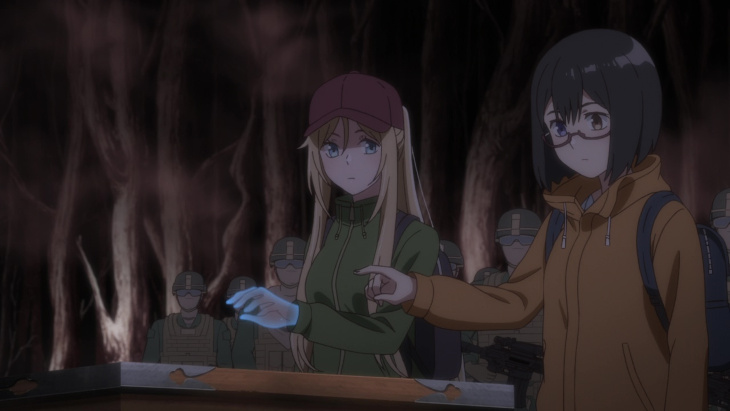
“Alone? ‘What happens if I die here?’ That’s what I was thinking right before I met Toriko. I wanted to be alone.”
While I can’t say I disliked my experience with Otherside Picnic, it did win my seasonal award for “Greatest Failure to Capitalize on Its Premise.” On paper, a yuri romance where the leads explore what is essentially the Upside-Down from Stranger Things is such a slam-dunk for me that I’m still a little startled by how disengaged I was from much of it. It’s a bad case of no one aspect being fully developed. The development of the relationship is slow, and if I hadn’t seen yuri listed amongst the genre tags, I’d be putting a question mark after each iteration of the word romance. The action and mystery elements often feel disjointed, with the action falling prey to mediocre production values and the “mysteries” often coming down to the characters just looking at a monster really hard until they understand how to defeat it. In the rare instances where a proper investigation occurs, one can see the glimmer of promise that Otherside Picnic’s premise offered, but far too much of the show consists of bland and repetitive case-of-the-week fare.
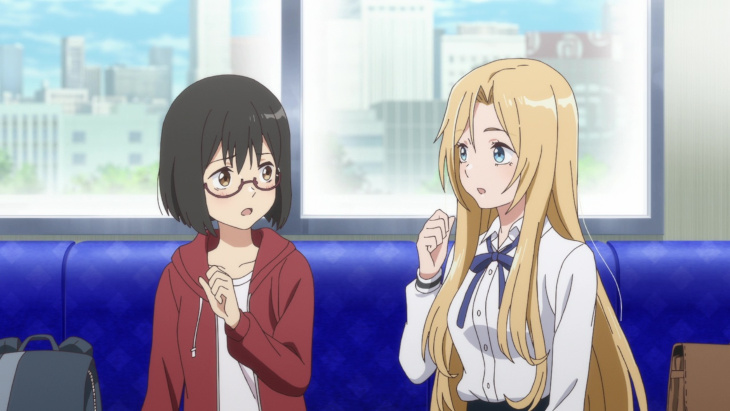
For those unfamiliar with the premise, Otherside Picnic follows two college students, Kamikochi Sorawo and Nishina Toriko, as they explore an enigmatic other world inhabited by the subjects of internet horror stories and other strange phenomena. As they encounter the “Otherside,” their bodies become altered by the phenomena there, with Sorawo’s right eye turning blue and gaining the ability to see through the illusions of the space, and Toriko’s hand becoming translucent and capable of interacting with the Otherside in unique ways. Several of the early episodes of the series have our leads stumble into the Otherside, either intentionally or not, and confront the entities that inhabit the space. This proves to be a problematic approach as it feels both redundant and often relegates our two leads into the role of passive victims rather than active investigators. The episodes also feel a bit detached from one another. Initially I thought this might be me simply not remembering how the previous episode left off, but the more I watched, the less that theory held up. I will aim to keep this spoiler free, but I do want to provide an example. Near the middle of the season, a group of soldiers is introduced to the viewer. They have an interaction with our two leads, but when that particular subplot reaches its end, the soldiers are left in a tentative state, and the rest of the cast don’t even mention them for several episodes. When they did come up again, I was actually taken aback as I’d simply assumed the show didn’t care about that subplot anymore. This disjointed and clunky approach pervades the entire season, and it makes it feel like the episodes were being written by people in three different workspaces who never communicated with one another. I’m being rather negative here, but there are aspects that I like. In the second half of the season, there are a few instances where Sorawo and Toriko get to act as investigators and Otherside specialists, and in those moments some of the promise of this show’s premise shines through.
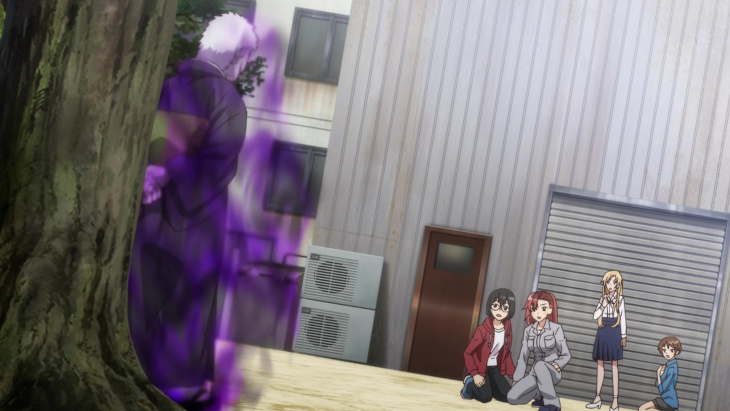
The previously mentioned disjointed flow of the plot unfortunately impacts characterization as well. Sorawo spends most of the series being sullen and passive aggressive, while Toriko is willful and determined to explore the Otherside despite its dangers. It would probably be feasible to make a drinking game out of it. Every time Sorawo complains internally that she doesn’t want to go or asks Toriko if she really wants to return to the Otherside, take a shot. Every time Toriko does what she wants without consulting others or just assumes Sorawo will come along with her, take a shot. In essence, the character development feels slow and stuttering, and this naturally extends to Toriko and Sorawo’s relationship as well. I suppose I should probably put the word “relationship” in quotation marks as, aside from the occasional embarrassment or jealousy on Sorawo’s part, there doesn’t seem to be any actual chemistry here. It’s as exciting as watching molasses pour, and it moves at roughly the same rate. We’re also introduced to Kozakura, a researcher with an interest in the Otherside who lacks the nerve to explore it firsthand, and Akari, a cheerful freshman at the girl’s university who suffers from an encounter with the Otherside. That’s almost all of our cast. There aren’t many recurring characters, and while Kozakura and Akari have fun personalities, they don’t get enough screen time to really lend much to the proceedings.
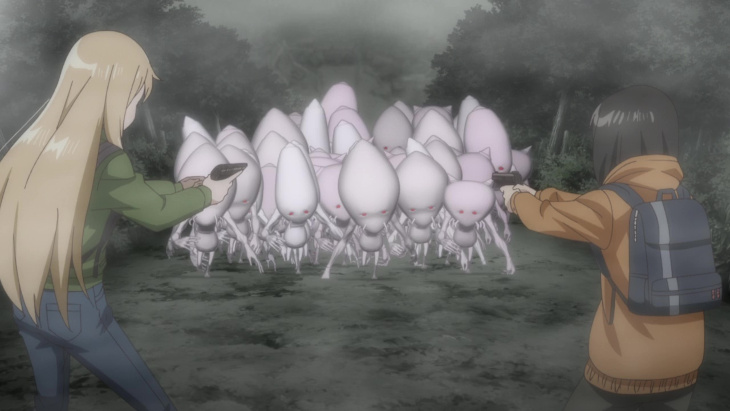
The production is… not great. This was a co-production between Liden Films and Felix Film. It certainly looks better than Last Dungeon, the other Liden Films anime I was following this season, but that is a notably low bar to clear. The visuals never look particularly crisp, and the CG the show employs often detracts from the experience. Thankfully, while I noted in my review of the first episode that it’s occasionally used for animating characters at a distance, the show doesn’t rely on it too heavily. Still, there are some monsters in this show that look positively ugly, and I mean that in the unintentional sense. Often they’ll be used to animate a crowd of creatures with maybe one or two traditionally animated ones being placed in the foreground, but the visual dissonance is distractingly stark. There is also a degree of inconsistency in the way the show is produced. Sorawo’s blue eye comes and goes constantly, and I was left questioning whether she was supposed to have a color contact or whether the color was supposed to be switching back and forth. It wasn’t until the halfway point of the season that Toriko makes a reference to Sorawo using a contact, and even then we never see her put it in or take it out. These types of inconsistencies further accentuate the uneven qualities of the storytelling. It’s also worth noting some English speakers may find the Japanese dub frustrating as there are multiple scenes of several characters speaking English of… varying quality. It wasn’t a make-or-break factor for me, but it can be distracting. At the time of writing this, the show’s licensed by Funimation, but it doesn’t have a dub, and I’ve seen no announcements pertaining to one being released.
Before I wrap up, a few Notes and Nitpicks:
- The show technically has an antagonist, but they don’t truly exist as a character through the course of the story, and we only receive hints of their actions and the repercussions. This is a story thread that’s ultimately left dangling.
- There are also hints of Sorawo possessing some type of Geas-style ability, but this only comes up in one episode and is never mentioned again. Fortunately, we do learn of the fate of the piece of farming equipment that the ladies bought when they got drunk… this series makes some strange choices regarding which pieces of the narrative it will prioritize.
- I was initially hopeful that Otherside Picnic’s relationship dynamics would develop at a moderate pace, given that both of our leads were college students, and wouldn’t just end at the stereotypical anime romance milestone that is handholding. It turns out I had my expectations way too high. If it wasn’t for the occasional glances and embarrassed reactions, I really would assume the “yuri” tag on this show was a mistake.

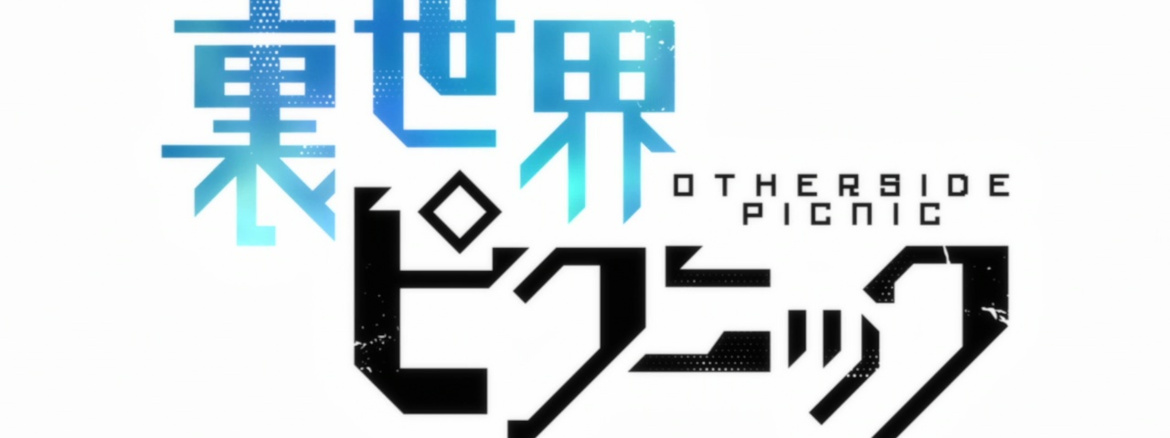


Add comment